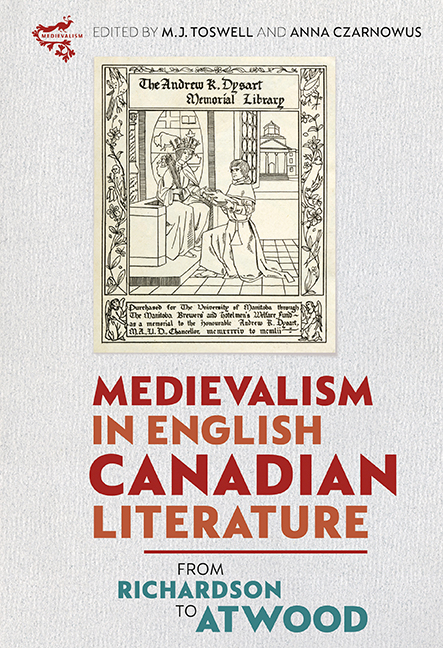Book contents
- Frontmatter
- Contents
- Introduction: English Canadian Medievalism
- 1 “Men of the North”: Archibald Lampman's Use of Incidents in the Lives of Medieval Monarchs and Aristocrats
- 2 “Going Back to the Middle Ages”: Tracing Medievalism in Julia Beckwith Hart's St. Ursula's Convent and John Richardson's Wacousta
- 3 John Richardson's Wacousta and the Transfer of Medievalist Romance
- 4 A Canadian Caliban in King Arthur's Court: Materialist Medievalism and Northern Gothic in William Wilfred Campbell's Mordred
- 5 Orientalist Medievalism in Early Canadian Periodicals
- 6 The Collegiate Gothic: Legitimacy and Inheritance in Robertson Davies's The Rebel Angels
- 7 Earle Birney as Public Poet: a Canadian Chaucer?
- 8 “That's what you get for being food”: Margaret Atwood's Symbolic Cannibalism 129
- 9 Lost in Allegory: Grief and Chivalry in Kit Pearson's A Perfect, Gentle Knight
- 10 Remembering the Romance: Medievalist Romance in Fantasy Fiction by Guy Gavriel Kay and Charles de Lint
- 11 Medievalisms and Romance Traditions in Guy Gavriel Kay's Ysabel
- 12 The Medieval Methods of Patrick DeWitt: Undermajordomo Minor
- Index
- Miscellaneous Endmatter
1 - “Men of the North”: Archibald Lampman's Use of Incidents in the Lives of Medieval Monarchs and Aristocrats
Published online by Cambridge University Press: 25 March 2020
- Frontmatter
- Contents
- Introduction: English Canadian Medievalism
- 1 “Men of the North”: Archibald Lampman's Use of Incidents in the Lives of Medieval Monarchs and Aristocrats
- 2 “Going Back to the Middle Ages”: Tracing Medievalism in Julia Beckwith Hart's St. Ursula's Convent and John Richardson's Wacousta
- 3 John Richardson's Wacousta and the Transfer of Medievalist Romance
- 4 A Canadian Caliban in King Arthur's Court: Materialist Medievalism and Northern Gothic in William Wilfred Campbell's Mordred
- 5 Orientalist Medievalism in Early Canadian Periodicals
- 6 The Collegiate Gothic: Legitimacy and Inheritance in Robertson Davies's The Rebel Angels
- 7 Earle Birney as Public Poet: a Canadian Chaucer?
- 8 “That's what you get for being food”: Margaret Atwood's Symbolic Cannibalism 129
- 9 Lost in Allegory: Grief and Chivalry in Kit Pearson's A Perfect, Gentle Knight
- 10 Remembering the Romance: Medievalist Romance in Fantasy Fiction by Guy Gavriel Kay and Charles de Lint
- 11 Medievalisms and Romance Traditions in Guy Gavriel Kay's Ysabel
- 12 The Medieval Methods of Patrick DeWitt: Undermajordomo Minor
- Index
- Miscellaneous Endmatter
Summary
‘‘THE MOST interesting among the […] Northern races were the Scandinavians or Norsemen […] Their Vikings and Sea kings, sallying forth in their frail vessels, made the North once more the terror of the world,” wrote R.G. Haliburton in 1869 in The Men of the North and Their Place in History; “[h]ere in the New World, we, who are sprung from these men of the North, are about to form a New Dominion in this Northern land, a worthy home for the old Frost Giant […] We are the Northmen of the New World” […] I am sick of hearing our poets forever harping upon the sunny South as ‘the land of love and song.’” Archibald Lampman (1861–1899) was living in Ontario in March 1869 when Haliburton delivered his lecture to the Montreal Literary Club, and there is no evidence that he read or knew of the influential lecture, but he certainly knew of the widespread belief that it articulated and helped to disseminate in the wake of Confederation (1867) – namely the belief that, as citizens of a northern nation, Canadians were environmentally and temperamentally aligned with the peoples of northern Europe and Britain, both modern and medieval. To a considerable extent, Canada's supposed northern identity, most visibly manifested in the ancient fortifications of Quebec City and the neo-Gothic architecture of the newly built Houses of Parliament in Ottawa, was one of its ways of differentiating the Dominion from the United States, which was proclaiming itself the new Rome through the neoclassical architecture of Washington, DC and several state capitals.
As a student at Trinity College, Toronto from 1879 to 1882, Lampman enthusiastically embraced the Hanoverian component of his ancestry; among the works that he wrote after leaving college and settling in Ottawa are two fairy tales – “Hans Fingerhut's Frog Lesson” and “The Fairy Fountain” – set respectively in Germany and Scandinavia; and one of his projects, he told a college friend in 1884, was
a strictly Canadian poem, local in incident and spirit, but cosmopolitan in form and manner […] in the metre of [Longfellow’s] Evangeline but more like [Goethe’s] Hermann and Dorothea, or, nearer still, to the translations from a Swedish poet, [Johan Ludwig] Runeberg, who wrote lovely things about the peasants of Finland.
- Type
- Chapter
- Information
- Medievalism in English Canadian LiteratureFrom Richardson to Atwood, pp. 17 - 35Publisher: Boydell & BrewerPrint publication year: 2020



